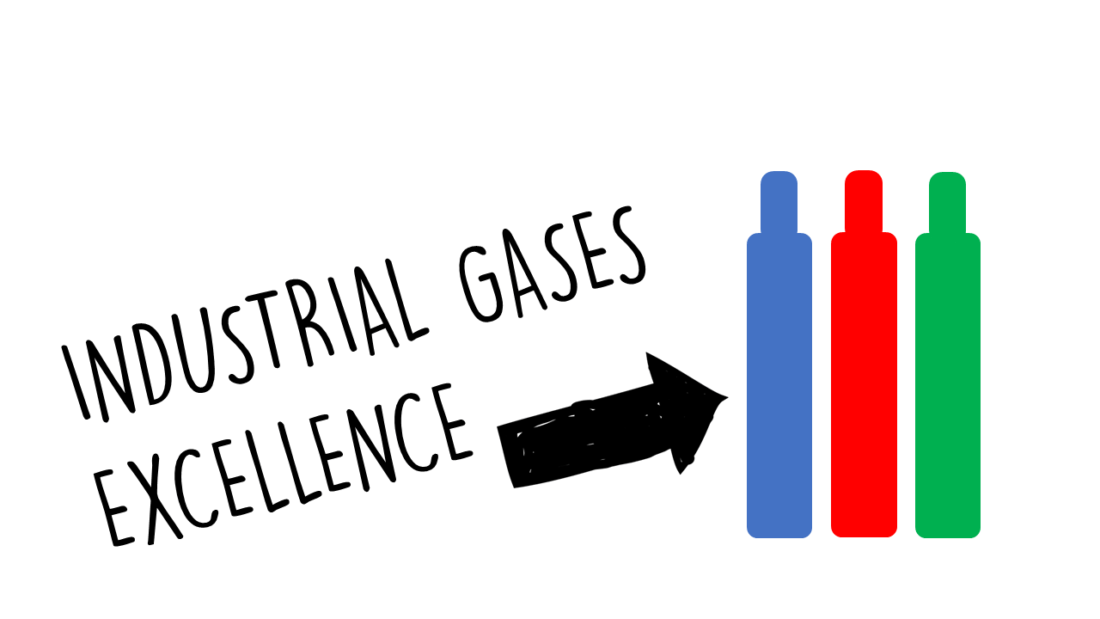Introduction
Industrial gases play a crucial role in the manufacturing industry, serving as a game-changer for factories around the world. These gases are used in various manufacturing processes to enhance productivity, efficiency, and overall output. From oxygen to nitrogen, industrial gases have become a versatile solution for a wide range of manufacturing processes. In this article, we will explore the role of industrial gases in manufacturing, their importance in boosting production, and the science behind how they enhance efficiency and output.
The Role of Industrial Gases in Manufacturing: A Game-Changer for Factories
Industrial gases are used in a wide range of manufacturing processes, making them an essential component of factory operations. These gases are used for various purposes such as cooling, heating, and cleaning. For example, in the steel industry, oxygen is used to increase the combustion rate of fuel, resulting in higher temperatures and faster production. In the food and beverage industry, carbon dioxide is used for carbonation and preservation. In the electronics industry, nitrogen is used for soldering and preventing oxidation.
Industries that heavily rely on industrial gases include steel, chemical, food and beverage, electronics, pharmaceuticals, and automotive. These industries require large quantities of industrial gases to carry out their manufacturing processes efficiently. Without industrial gases, these industries would face significant challenges in meeting production demands and maintaining product quality.
Understanding the Importance of Industrial Gases in Boosting Production
Industrial gases play a crucial role in boosting production and efficiency in factories. One of the key ways they achieve this is by providing a controlled environment for manufacturing processes. For example, nitrogen is often used to create an inert atmosphere that prevents oxidation during soldering or welding processes. This helps to maintain product quality and reduce defects.
Another way industrial gases enhance productivity is by improving combustion efficiency. Oxygen is commonly used to increase the combustion rate of fuel, resulting in higher temperatures and faster production. This is particularly important in industries such as steel manufacturing, where high temperatures are required to melt and shape metals.
Furthermore, industrial gases can also be used to clean and purify materials. For example, carbon dioxide is often used in the food and beverage industry to remove impurities and extend the shelf life of products. This helps to reduce waste and improve overall efficiency in the manufacturing process.
The Science Behind Industrial Gases: How They Enhance Efficiency and Output
Industrial gases have unique properties and characteristics that contribute to improving efficiency and output in factories. One of the key properties of industrial gases is their ability to easily expand and contract. This makes them ideal for applications such as cooling and heating. For example, nitrogen can be used to rapidly cool down materials during the manufacturing process, reducing downtime and increasing productivity.
Another important property of industrial gases is their ability to create a controlled environment. By adjusting the composition of gases, manufacturers can create an atmosphere that is conducive to their specific manufacturing processes. This helps to ensure consistent product quality and reduce defects.
Additionally, industrial gases can also be used as a source of energy. For example, hydrogen gas can be used as a fuel source for power generation or as a raw material for chemical reactions. This not only reduces reliance on traditional energy sources but also helps to reduce carbon emissions.
Industrial Gases: A Versatile Solution for Various Manufacturing Processes
Industrial gases are a versatile solution for a wide range of manufacturing processes. There are several types of industrial gases that are commonly used in factories, including oxygen, nitrogen, carbon dioxide, hydrogen, and argon.
Oxygen is often used for combustion processes, such as in steel manufacturing or glass production. It helps to increase the combustion rate of fuel, resulting in higher temperatures and faster production.
Nitrogen is commonly used for inerting applications, such as preventing oxidation during soldering or welding processes. It creates an inert atmosphere that helps to maintain product quality and reduce defects.
Carbon dioxide is used for various purposes, including carbonation in the food and beverage industry and as a cooling agent in the electronics industry. It is also used for cleaning and purifying materials.
Hydrogen gas is used as a fuel source for power generation or as a raw material for chemical reactions. It is a clean and efficient source of energy that helps to reduce carbon emissions.
Argon is often used as a shielding gas in welding processes to protect the weld from atmospheric contamination. It creates a stable and controlled environment for welding, resulting in high-quality welds.
From Oxygen to Nitrogen: Exploring the Different Types of Industrial Gases Used in Factories
Let’s take an in-depth look at the different types of industrial gases and their specific uses:
1. Oxygen: Oxygen is one of the most widely used industrial gases in manufacturing. It is used for combustion processes, such as in steel manufacturing, glass production, and chemical reactions. Oxygen helps to increase the combustion rate of fuel, resulting in higher temperatures and faster production.
2. Nitrogen: Nitrogen is commonly used for inerting applications, where it creates an inert atmosphere to prevent oxidation during soldering or welding processes. It is also used for cooling and purging applications, where it helps to maintain product quality and reduce defects.
3. Carbon Dioxide: Carbon dioxide is used for various purposes in manufacturing. In the food and beverage industry, it is used for carbonation, preservation, and as a cooling agent. In the electronics industry, it is used for cleaning and purifying materials. Carbon dioxide is also used in welding processes to create a shielding gas.
4. Hydrogen: Hydrogen gas is a clean and efficient source of energy that is used for power generation and as a raw material for chemical reactions. It can be produced through electrolysis or by reforming natural gas.
5. Argon: Argon is often used as a shielding gas in welding processes to protect the weld from atmospheric contamination. It creates a stable and controlled environment for welding, resulting in high-quality welds.
Each type of industrial gas has its own unique benefits and applications, making them essential components of manufacturing processes.
The Benefits of Industrial Gases in Reducing Downtime and Improving Productivity
Industrial gases play a crucial role in reducing downtime and improving productivity in factories. One of the key benefits of using industrial gases is their ability to create a controlled environment for manufacturing processes. By adjusting the composition of gases, manufacturers can create an atmosphere that is conducive to their specific manufacturing processes. This helps to ensure consistent product quality and reduce defects, ultimately reducing downtime caused by rework or product failures.
Another benefit of using industrial gases is their ability to improve combustion efficiency. Oxygen, for example, is commonly used to increase the combustion rate of fuel, resulting in higher temperatures and faster production. This helps to reduce cycle times and increase overall productivity.
Furthermore, industrial gases can also be used for cleaning and purifying materials. Carbon dioxide, for example, is often used in the food and beverage industry to remove impurities and extend the shelf life of products. This helps to reduce waste and improve overall efficiency in the manufacturing process.
Overall, the use of industrial gases in manufacturing processes helps to minimize downtime, improve productivity, and reduce costs.
Cutting-Edge Applications: How Industrial Gases Revolutionize Production Techniques
Industrial gases have revolutionized production techniques in various industries. One example is the use of nitrogen in the electronics industry. Nitrogen is commonly used for soldering processes, where it creates an inert atmosphere that prevents oxidation and improves solder joint quality. This has led to significant advancements in electronics manufacturing, allowing for smaller and more complex electronic devices.
Another example is the use of oxygen in the steel industry. Oxygen is used to increase the combustion rate of fuel, resulting in higher temperatures and faster production. This has revolutionized steel manufacturing, allowing for the production of larger quantities of steel in a shorter amount of time.
Furthermore, the use of industrial gases in the food and beverage industry has revolutionized food preservation techniques. Carbon dioxide, for example, is used to extend the shelf life of products by inhibiting the growth of bacteria and other microorganisms. This has led to improved food safety and reduced food waste.
Overall, industrial gases have revolutionized production techniques in various industries, leading to increased efficiency, improved product quality, and reduced costs.
Industrial Gases and Environmental Sustainability: A Win-Win for Factories and the Planet
Industrial gases not only benefit factories but also contribute to environmental sustainability. One of the key ways industrial gases contribute to sustainability is by reducing carbon emissions. Hydrogen gas, for example, is a clean and efficient source of energy that can be used for power generation or as a raw material for chemical reactions. By using hydrogen gas instead of traditional fossil fuels, factories can significantly reduce their carbon footprint.
Furthermore, industrial gases can also be used to capture and store carbon dioxide emissions. Carbon capture and storage (CCS) technologies are being developed to capture carbon dioxide emissions from industrial processes and store them underground. This helps to prevent carbon dioxide from being released into the atmosphere, reducing greenhouse gas emissions.
Additionally, industrial gases can also be used for wastewater treatment and air pollution control. For example, ozone gas is commonly used for water disinfection in wastewater treatment plants. It is also used for air purification in industries such as semiconductor manufacturing.
Overall, the use of industrial gases in manufacturing processes not only benefits factories but also contributes to environmental sustainability by reducing carbon emissions and improving air and water quality.
Case Studies: Real-Life Examples of How Industrial Gases Transformed Factory Operations
There are numerous real-life examples of how industrial gases have transformed factory operations. One such example is the steel industry. By using oxygen in the steelmaking process, factories have been able to significantly increase production rates and reduce energy consumption. This has led to improved efficiency and reduced costs.
Another example is the electronics industry. Nitrogen gas is commonly used for soldering processes, where it creates an inert atmosphere that prevents oxidation and improves solder joint quality. This has led to improved product quality and reduced defects, ultimately improving customer satisfaction.
Furthermore, the food and beverage industry has also benefited from the use of industrial gases. Carbon dioxide, for example, is used for carbonation and preservation. By using carbon dioxide, factories can extend the shelf life of products and reduce waste.
These case studies demonstrate the significant impact that industrial gases can have on factory operations, leading to improved efficiency, increased productivity, and reduced costs.
The Future of Industrial Gases: Innovations and Trends in Enhancing Production Efficiency
The future of industrial gases looks promising, with ongoing innovations and trends aimed at enhancing production efficiency. One of the key trends in the industry is the development of advanced gas delivery systems. These systems are designed to provide precise control over gas flow rates and compositions, allowing for more efficient and cost-effective manufacturing processes.
Another trend is the development of new gas purification technologies. These technologies aim to remove impurities from industrial gases, ensuring higher product quality and reducing the risk of contamination.
Furthermore, there is a growing focus on sustainability in the industrial gases industry. Companies are investing in research and development to develop cleaner and more efficient gas production methods. This includes the use of renewable energy sources for gas production and the development of carbon capture and storage technologies.
Overall, the future of industrial gases is focused on enhancing production efficiency while also prioritizing sustainability and environmental responsibility.
Conclusion
In conclusion, industrial gases play a crucial role in manufacturing processes, serving as a game-changer for factories around the world. These gases are used in various manufacturing processes to enhance productivity, efficiency, and overall output. From oxygen to nitrogen, industrial gases have become a versatile solution for a wide range of manufacturing processes. They provide a controlled environment, improve combustion efficiency, and can be used for cleaning and purifying materials. Industrial gases also contribute to environmental sustainability by reducing carbon emissions and improving air and water quality. The future of industrial gases looks promising, with ongoing innovations and trends aimed at enhancing production efficiency while prioritizing sustainability.




